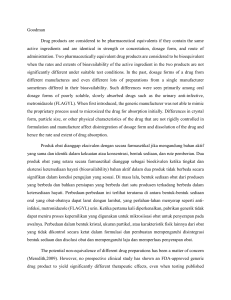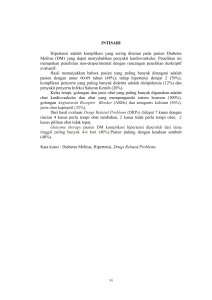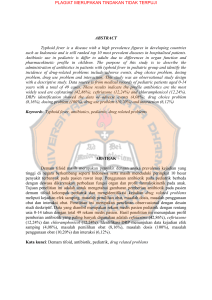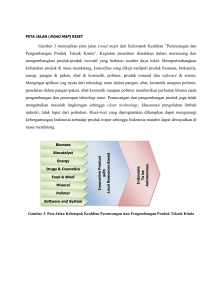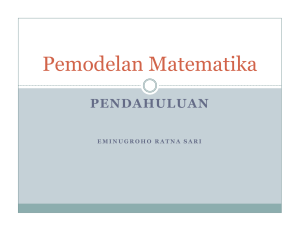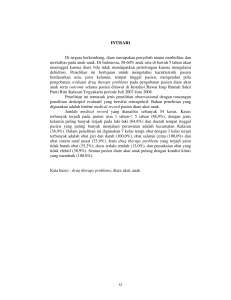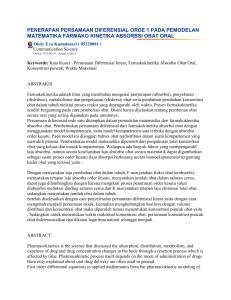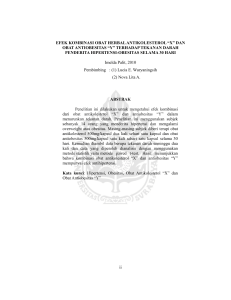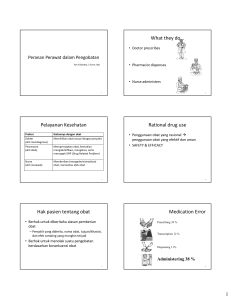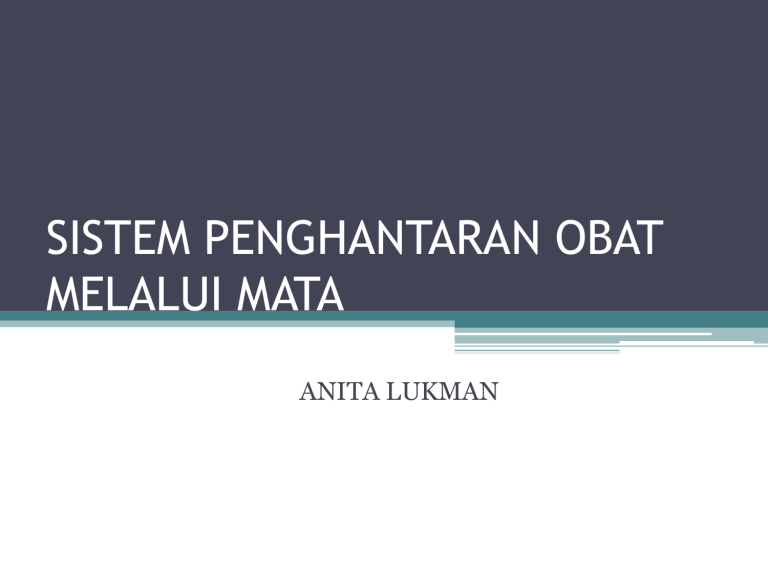
SISTEM PENGHANTARAN OBAT MELALUI MATA ANITA LUKMAN PENDAHULUAN • Bola mata merupakan salah satu organ yang bisa digunakan untuk pemberian obat namun sangat terlindung terhadap zat asing melalui berbagai barrier. • Hal ini menjadi salah satu kendala untuk pengembangan formulasi preparat mata • Sediaan konvensional seperti salep, suspensi atau tetes mata relatif tidak efisien dalam pengobatan mata Structure of Eye • The eye is composed of two components 1. anterior segment: consists of front one-third of eye that mainly includes pupil, cornea, iris, ciliary body, aqueous humor, and lens 2. posterior segment: consists of the back two-thirds of the eye that includes vitreous humor, retina, choroid, macula, and optic nerve • For the treatment of the anterior segment of the eye (cornea, conjunctiva, sclera, anterior uvea), usually topical ocular eye-drops are used. • An eye-drop, irrespective of the instilled volume, often eliminates rapidly within five to six minutes after administration, and only a small amount (1–3%) of an eye-drop actually reaches the intraocular tissue. • Thus, it is difficult to provide and maintain an adequate concentration of drug in the precorneal area. • More than 75% of applied ophthalmic solution is lost via nasolachrymal drainage and absorbed systemically via conjunctiva, hence ocular drug availability is very low. • To increase ocular bioavailability and prolong the retention time on the ocular surface, numerous ophthalmic vehicles such as viscous solutions, suspensions, emulsions, ointments, aqueous gels, and polymeric inserts, have been investigated for topical application to the eye. Routes of drug administration • Topical Administration ▫ ▫ ▫ ▫ ▫ Drops Perfusion Sprays Ointments Particulates • Intraocular drug delivery ▫ ▫ ▫ ▫ Liposomes Microparticulates and nanoparticles Intraocular devices Iontophoresis Drops • The most common form of topical administration is the eye drop. It is apparently easy to use, relatively inexpensive and does not impair vision. • The major problems with these types of formulation are their inability to sustain high local concentrations of drug and they only have a short contact time with the eye • Contact time between the vehicle and the eye can be increased by the addition of polymers such as polyvinyl alcohol and methylcellulose • Drainage from the eye may also be reduced by punctual occlusion or simple eyelid closure, which prolongs the contact time of the drug with the external eye. Perfusion • Continuous and constant perfusion of the eye with drug solutions can be achieved by the use of ambulatory motor driven syringes that deliver drug solutions through fine polyethylene tubing positioned in the conjunctival sac • The flow rate of the perfusate through a minipump can be adjusted to produce continuous irrigation of the eye surface (3– 6 ml/min) or slow delivery (0.2 ml/min) to avoid overflow • This system allows the use of a lower drug concentration than used in conventional eye-drops, yet will produce the same potency. Side effects are reduced and constant therapeutic action is maintained Sprays • Spray systems produce similar results to eye-drops in terms of duration of drug action and side effects. Sprays have several advantages over eyedrops: 1. a more uniform spread of drug can be achieved 2. precise instillation requiring less manual dexterity than for eye-drop administration and is particularly useful for treating patients with unsteady hand movements 3. contamination and eye injury due to eye-drop application are avoided 4. spray delivery causes less reflex lacrimation. 5. Can be used by patients who have difficulty bending their neck back to administer drops. Ointments • Ointments are not as popular as eye drops since vision is blurred by the oil base, making ointments impractical for daytime use • They are usually applied for overnight use or if the eye is to be bandaged. They are especially useful for pediatric use since small children often wash out drugs by crying. • Ointments are generally non-toxic and safe to use on the exterior of the surface of the eye. However, ointment bases such as lanolin, petrolatum and vegetable oil are toxic to the interior of the eye, causing corneal oedema, vascularization and scarring Poin Penting Untuk Optimasi Penghantaran Obat Melalui Mata • 1. Meningkatkan waktu kontak ocular • 2. Meningkatkan permeabilitas kornea • 3. Meningkatkan pencapaian obat ke tempat spesifik Mekanisme Absorpsi Melalui Mata 1. Non-corneal absorption - Penetrasi melalui sclera dan conjungtiva untuk masuk kedalam jaringan mata 2. Corneal absorption - Outer epithelium : hanya bisa untuk ion kecil dan molekul lipofilik - Trans cellular transport : Transport antara epitelium cornea dan stroma Faktor-faktor yang mempengaruhi bioavailabilitas intraocular 1. Pemasukan dan pengeluaran dari Lacrimal fluids 2. Efisiensi pengeringan naso-lacrimal 3. Ikatan obat dengan protein dari lacrimal-fluids 4. Pengenceran dengan air mata Peran polimer pada ODDS 1. Meningkatkan viskositas 2. Mengurangi pengeringan larutan 3. Pembawa polimer mucoadhesif : Tertahan di mata melalui ikatan non kovalen dengan conjungtival mucine Klasifikasi bentuk sediaan melalui mata 1. Berdasarkan rute pemberian - Topical solution : Multiple dose container with preservatives - Intraocular solution : for surgery, single dose , without preservatives - Ophthalmic solution injection : Intraocular injection, diberikan pada jaringan mata, tanpa pengawet Retinal Disease Diabetic retinopathy 2. Berdasarkan bentuk fisik - Larutan - Suspensi - Salep - Gels - Eye lotions - Solid inserts Preparat Mata Diaplikasikan secara topikal melalui kornea, atau ditanamkan diantara bola mata dan kelopak mata bawah - Larutan Diencerkan dengan air mata, dan diberikan berkali-kali - Suspensi Waktu kontak lebih lama, berpotensi menyebabkan iritasi akibat ukuran partikel obat - Salep - Waktu kontak lebih lama, stabilitas penyimpanan lebih besar, menghasilkan lapisan film menutupi mata dan mengaburkan pandangan - Emulsi Memperpanjang pelepasan obat dan mengaburkan pandangan, pasien tidak nyaman - Gel Nyaman digunakan, sedikit mengaburkan pandangan tetapi kekurangannya kelopak mata menjadi berkerut serta tidak dapat mengontrol kecepatan difusi obat - Sistem penghantaran terkontrol Kecepatan pelepasan obat konstan pada waktu yang lama, meningkatkan absorpsi kornea, efek samping obat yang tidak serius atau dapat ditoleransi pasien Keuntungan 1. Meningkatkan kontak pada mata sehingga meningkatkan bioavailabilitas. 2. Memungkinkan tersedianya obat dengan pelepasan yang diperpanjang sehingga efek lebih baik 3. Efek samping pada mata dan sistemik lebih rendah 4. Meningkatkan usia simpan untuk sediaan larutan 5. Pengecualian dari pengawet sehingga mengurangi resiko reaksi sensitif 6. Memungkinkan untuk mencapai jaringan internal ocular melalui rute non-kornea 7. Mengurangi pemberian yang berulang sehingga penerimaan pasien lebih baik 8. Dosis pemberian pada mata akurat yang dapat mempertahankan secara penuh pada tempat pemberian sehingga terapi lebih baik Klasifikasi • • • • • • • • • Bentuk sediaan mucoadhesive Ocular inserts Pelindung kolagen Hydrogel tipe kontak lens Ocular iontophoresis Larutan polimer Peningkat penetrasi ocular Sistem fase transisi Sistem partikulat seperti microspheres dan nanopartikel • Vesicular sistem seperti liposom, niosom, phamacosome dan discomes Bentuk Sediaan Mucoadesif • Sistem ini secara signifikan memperpanjang waktu tinggal obat. • Polimer mucoadesif biasanya merupakan makromolekul hidrokoloid Polimer Mucoadhesif Ocular • Non-ionik : HPMC • Polikationik : Chitosan, Dextran Polianionik : Derivat Polyacrylic acid (Carbopol, Polycarbophils, CMC) Faktor yang mempengaruhi kekuatan mucoadhesif • • • • Fleksibilitas rantai BM pH Kekuatan ion Ophthalmic Inserts • Merupakan polymeric ocular controlled drug delivery system • Obat dalam bentuk dispersi atau larutan dalam polimer yang sesuai • Merupakan preparat steril dengan konsistensi padat atau semipadat dan ukuran serta bentuknya khusus dirancang untuk penggunaan pada mata • Tujuannya adalah untuk meningkatkan waktu kontak untuk pengobatan topikal/sistemik untuk pelepasan tertunda/terkontrol pada jaringan konjungtiva Klasifikasi Ophthalmic Inserts 1. Soluble 2. Insoluble (osmotic, diffusion, contact lens) 3. Bioerodible Soluble Opthalmic Inserts • Alat larut air yang berbentuk oval kecil • Tidak membutuhkan untuk dilepaskan setelah diaplikasikan • Sejumlah obat yang dilepaskan akan tergantung pada jumlah agent pengikat, konsentrasi dari larutan obat • Dalam 10-15 detik berbentuk softlens • Dalam 10-15 menit akan menjadi cairan kental • Setelah 30-60 menit menjadi larutan polimer • Jenis - Berdasarkan polimer alami seperti kolagen - Berdasarkan polimer semi sintetik atau sintetik Faktor yang mempengaruhi pelepasan obat 1. Penetrasi dari cairan 2. Pengembangan matriks 3. Disolusi obat dan polimer 4. Relaksasi polimeric chain • Komponen soluble inserts 1. Polimer sintetis larut air - Derivat selulosa (HPMC, MC, HEC, HPC) - PVA, Ethylene vinylacetate co-polymer 2. Bahan tambahan - Plasticizer (PEG, Glyserin, Propilen glikol) - Polimer salut enteric (HPMC phtalate) - Agen pengompleks ( PVP) - Bioadhesiva (Polyacrylic acids) • Keuntungan 1. Menggantikan 4-12 kali pemberian obat tetes mata 2. Menggantikan 3-6 kali pemakaian ointment Intraocular devices • The administration of medications by implants or depot devices is a very rapidly developing technology in ocular therapeutics. These overcome the potential hazards associated with repeated intravitreal injection such as clouding of the vitreous humor, retinal detachment and endophthalmitis • Implantable devices have been developed that serve two major purposes. First, to release of drug at zero order rates, thus improving the predictability of drug action, and second, to release of the drug over several months, reducing dramatically the frequency of administration. • Vitrasert® is a commercially available sustained release intraocular device for ganciclovir approved for use in-patients suffering from cytomegalovirus Vitrasert® intraocular device Osmotics Inserts • Komponen 1. Water permeable matrix : Ethylene- vinyl ester copolymers, Polyethylene 2. Membran semipermeabel : Derivat selulosa asetat, ethyl vinyl acetat, poliester acrylic, asam methacrylic 3. Osmotic agents - Inorganic : MgSO4, NaCl, K2PO4, Na2SO4 - Organik : Ca Lactat, Mg Suksinat, asam tartrat - Karbohidrat : Sorbitol, Manitol, Glukosa, Sukrosa Insoluble Ophthalmic Inserts • Diffusion Inserts ( Central reservoir, Microporous membran) • Contacs Lens • Controlled ocular drug delivery systems meningkatkan efisiensi obat dengan mengurangi wastage dan dengan meningkatkan absorpsi dengan meningkatnya waktu kontak obat • Meningkatkan kepatuhan pasien dengan berkurangnya frekwensi dosis • Mengurangi dosis sehingga juga akan mengurangi efek samping obat • Kelemahannya kurang popular karena pemakaian dengan meletakkan dan melepaskan sediaan dari kelopak mata bawah secara periodik • Kurang nyaman pada mata Iontophoresis • Iontophoresis (see transdermal lecture notes) facilitates drug penetration through the intact corneal epithelium • The solution of the drug is kept in contact with the cornea in an eyecup bearing an electrode. A potential difference is applied with the electrode in the cup having the same charge as the ionized drug, so that the drug flux is into the tissue • This method of administration is very rarely used, except under carefully controlled conditions. Iontophoresis allows penetration of antibiotics that are ionised and therefore do not penetrate by other methods, for example, polymyxin B used in the local treatment of infections • Commonly reported toxic effects include slight retinal and choroidal burns and retinal pigment epithelial and choroidal necrosis, corneal epithelial oedema, persistent corneal opacities and polymorphonuclear cell infiltration. Other disadvantages of iontophoresis include side effects such as itching, erythema and general irritation
